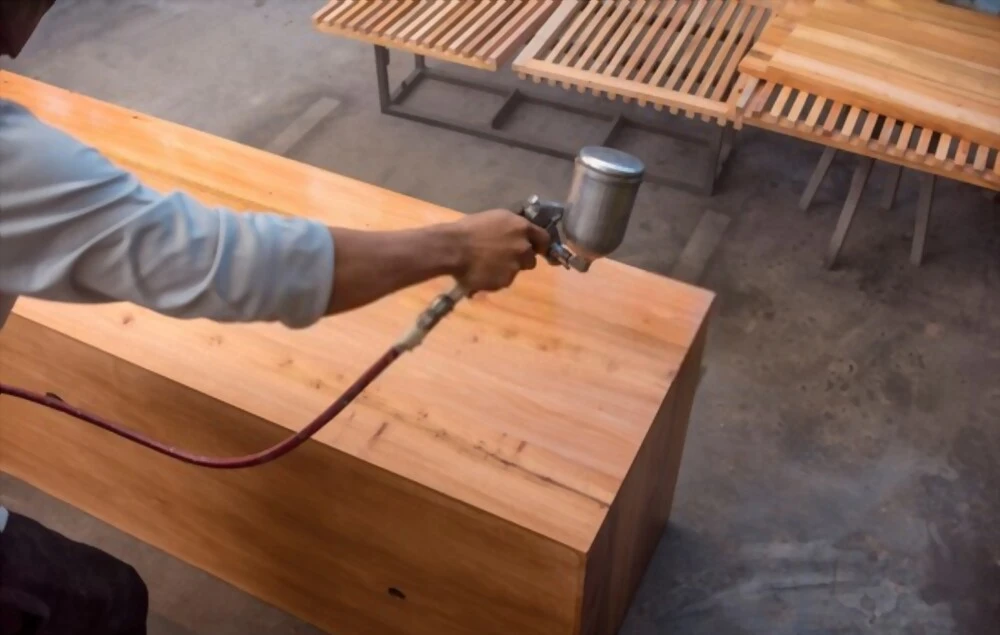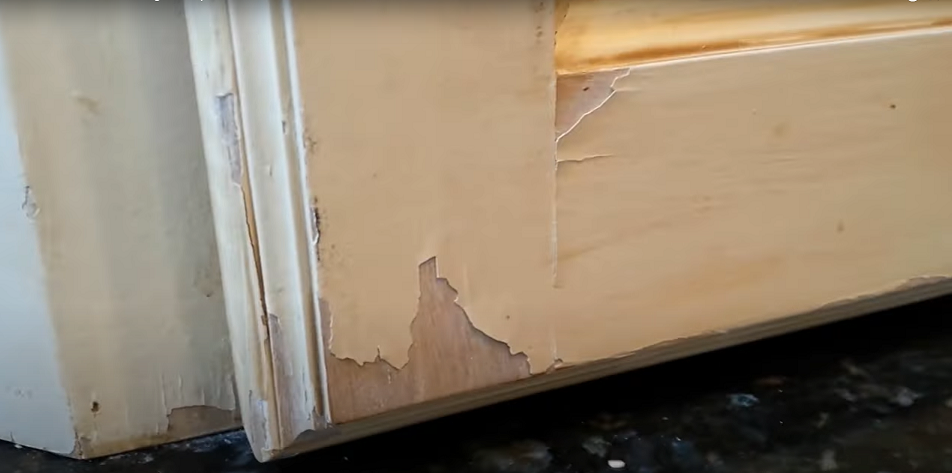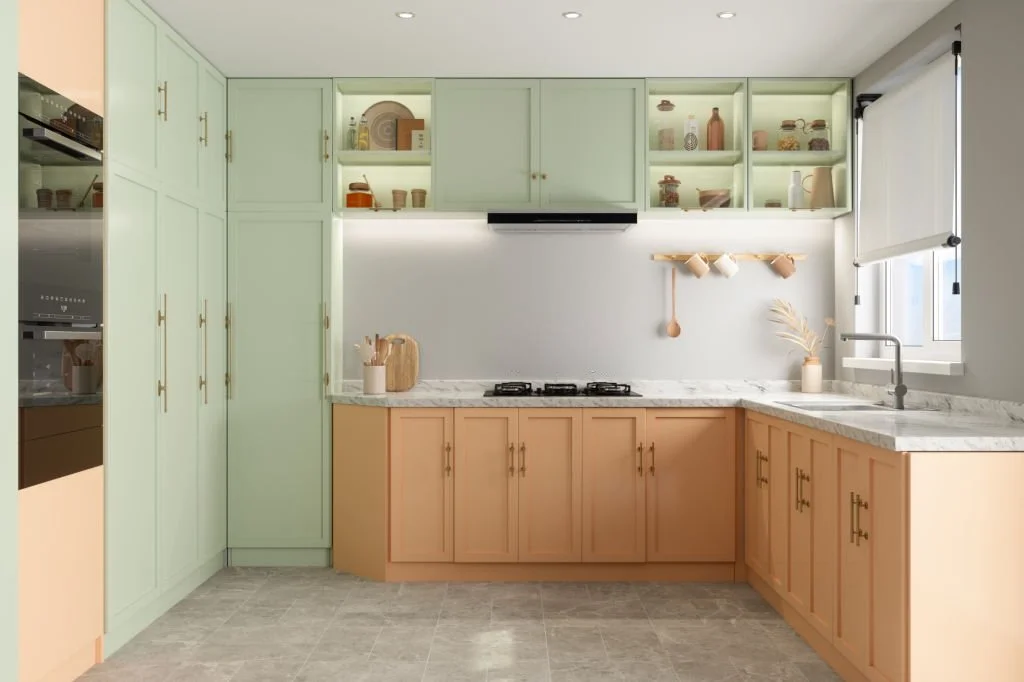
Is lacquer paint good for cabinets? It can be, but depends on your needs. While this paint provides a high-gloss finish and dries quickly, it’s also brittle, can chip easily, and requires more upkeep compared to other paints like latex or oil-based.
Choosing the right paint for your kitchen cabinets can be a game-changer for the overall aesthetics of your kitchen.
Lacquer paint can create a visually appealing, high-gloss finish and is known for its quick-drying properties. However, its brittleness and higher maintenance needs compared to other types of paint like latex, enamel or oil-based paint may make it less suitable for some kitchens.
In this comprehensive guide, I’ll delve deeper into the world of lacquer paint, exploring its pros and cons and comparing it with other popular paint options. Whether you’re undertaking a kitchen makeover or simply curious about it, this article will provide valuable insights from a pro painter’s perspective.
- Why Is Lacquer Paint Good For Kitchen Cabinets? The Benefits Of Using It For Kitchen Cabinets
- The Downsides of Lacquer Paint for Kitchen Cabinets
- Comparing Lacquer Paint with Other Types of Paint
- How to Apply Lacquer Paint on Kitchen Cabinets
- FAQ
- 1. Can lacquer paint be used on cabinets?
- 2. What type of lacquer is best for kitchen cabinets?
- 3. How long does it take for lacquer finished cabinets to dry?
- 4. Is lacquer durable for cabinetry?
- 5. Can lacquer change the color of my cabinetry?
- 6. Can I apply a second coat of lacquer?
- 7. Should I sand my cabinets before using lacquer?
- 8. Is it possible to utilize lacquer for refinishing my aged cabinets?
- 9. What is lacquer paint?
- 10. What are the types of Lacquer Paint?
- Conclusion
Why Is Lacquer Paint Good For Kitchen Cabinets? The Benefits Of Using It For Kitchen Cabinets
As a professional painter with extensive experience working on various projects, I have had the opportunity to utilize a wide array of paint products, including lacquer, on kitchen cabinetry.
Throughout my career, I have come to appreciate the numerous benefits that lacquer offers when it comes to enhancing the look and durability of the cabinetry.
One of the standout advantages of using lacquer is the impeccable finish it produces. The glossy sheen achieved with it can truly transform a kitchen, imparting a sense of sophistication and modernity.
The reflective surface of lacquer adds depth and visual interest to the cabinets, making them a striking focal point within the space. Whether you opt for bold, vibrant colors or more subtle, neutral shades, it can elevate the overall aesthetics of your kitchen.
In addition to the remarkable finish, lacquer paint provides a broad spectrum of color options. This versatility allows homeowners to exercise their creativity and select hues that perfectly complement their kitchen decor and personal style.
Whether you desire a vibrant pop of color or a more understated and elegant look, this paint can accommodate your design preferences with its extensive range of choices.
One practical advantage of lacquer is its quick drying time. As a professional painter, I value the efficiency and time-saving aspect that this offers.
The rapid drying nature of lacquer paint enables multiple coats to be applied within a relatively short period, expediting the painting process. This not only saves time but also ensures a smoother and more uniform finish, enhancing the overall appearance of the cabinetry.
Durability is a crucial consideration when it comes to painting cabinets, as they endure constant use, moisture, and the occasional spill. In this regard, lacquer excels.
When applied correctly, lacquer forms a robust protective layer on the cabinets, enhancing their resistance to everyday wear and tear. It withstands the demands of a high-traffic area like the kitchen, preserving its pristine appearance for an extended period.
However, it is essential to highlight that achieving a flawless finish with lacquer necessitates meticulous surface preparation and skillful application. It tends to accentuate imperfections, such as scratches or uneven surfaces.
Therefore, thorough sanding and cleaning of the cabinetry are imperative before applying the paint. Additionally, the application technique must be precise to ensure an even coat without drips or streaks.
Pros
- Stunning Finish: It provide a high gloss finish that is hard to match with other types of paints. A high-gloss lacquer kitchen has a unique visual appeal that many homeowners love.
- Fast Dry Time: It dries quickly, allowing for multiple coats in a shorter time. This can speed up the project significantly.
- Ease of Application: With the right brush and primer, this paint is easy to apply, saving time and effort.
- Protection and easy cleaning: It protects cabinets and is relatively easy to clean.
- Tough surface: It creates a durable and tough surface.
- Smooth and seamless appearance: It results in a thicker and seamless coat, enhancing the overall look of furniture and cabinets.
- Excellent durability and chemical resistance: Pre-catalyzed lacquer offers excellent durability, hardness, and chemical resistance
- Versatility: It can be used on various surfaces, including wood, metal, and plastic. This makes it a flexible choice for a range of projects.
- UV Resistance: It is resistant to UV radiation, which makes it an excellent choice for outdoor applications where the paint will be exposed to sunlight.
- Non-yellowing: Unlike some other finishes, it will not yellow over time. This means that your cabinets will retain their original color for longer.
- Tintable: Lacquer can be tinted to create a variety of colors and effects. This allows for greater customization in your design choices.
- Smooth Finish: It creates a smooth finish free from brush strokes or roller marks. This can give your cabinets a professional, high-quality appearance.
- Chemical Resistance: It is resistant to chemicals and solvents, making it ideal for areas where it may come into contact with various substances.
- Easy Repair: It can be easily repaired by sanding and reapplying a new coat of lacquer, making it perfect for furniture and other wooden surfaces.
The Downsides of Lacquer Paint for Kitchen Cabinets
While lacquer paint offers numerous benefits, it is important to consider some notable drawbacks that have influenced my decision to reconsider its use for certain projects.
One significant disadvantage of lacquer is its brittleness. Over time, I have witnessed instances where the lacquer finish on kitchen cabinets chips or cracks due to the natural expansion and contraction of the wood.

This can occur as a result of changes in temperature and humidity levels within the kitchen environment. Additionally, lacquer finishes are not particularly resistant to repeated water drips or high humidity, which can further contribute to the deterioration of the finish.
Maintenance is another consideration when using lacquer paint. Over time, lacquer finishes tend to wear away with normal use of the cabinets. The constant opening and closing of cabinet doors, as well as contact with hands and utensils, can gradually degrade the lacquer surface.
Consequently, regular maintenance, such as periodic reapplication or touch-ups, may be required to preserve the appearance of the cabinetry. If you prefer a long-lasting finish that requires minimal upkeep, latex paints or alkyd paint may be more suitable options to consider.
Cost is an additional factor to bear in mind when contemplating lacquer for cabinets. Generally, it tends to be more expensive compared to other types of paint, such as latex or oil-based paints.
This can make it less favorable for those working within a strict budget. It is essential to carefully consider the costs associated with lacquer, including the price of the paint itself and any additional tools or materials required for its application.
While lacquer has the potential to transform a kitchen with its glossy finish, it is important to weigh its disadvantages against the desired outcome.
The brittleness and susceptibility to wear and tear may make lacquer less suitable for kitchens prone to significant temperature fluctuations or high humidity. Moreover, the higher cost of lacquer paint compared to other paint options may present budgetary constraints for some homeowners.
Before making a final decision, it is crucial to evaluate these factors and determine whether lacquer paint aligns with your specific needs and circumstances.
Assessing the durability requirements, considering the environmental conditions of your kitchen, and exploring alternative paint options can help ensure the longevity and satisfaction of your cabinet finish.
Cons
Despite these benefits, there are a few significant disadvantages that have led me to reconsider lacquer for some projects.
- Brittleness: It can be brittle. I have seen the finish chip due to the natural expansion and contraction of the wood. Lacquer finishes don’t stand up well to repeated water drips or in humid areas.
- Maintenance: Lacquer finishes may require more frequent maintenance to preserve their shine and durability over time. Over time, its finishes tend to wear away with normal cabinet use. If you want a long-lasting finish, latex paints or alkyd paint may be a better choice.
- Multiple coats may be required: It may necessitate several coats to achieve the desired finish.
- Higher cost compared to paint: It can be slightly more expensive than traditional paint, depending on the specific type chosen.
- Proper ventilation is essential: It should only be used in well-ventilated areas due to its fumes. It is advisable to hire a professional painter who can ensure the right ventilation and utilize appropriate protective measures.
- Application Method: It is commonly spray painted on, as opposed to painted on directly. This means you would need to invest in a paint sprayer, which could be an additional cost.
- Durability: It isn’t as durable as other types of paint. It’s known to crack when it ages and isn’t very protective against abrasion, chemicals, or liquids.
- Environmental Impact: It often contain volatile organic compounds (VOCs) which are harmful to the environment and can contribute to air pollution.
- Health Risks: The solvents in lacquer are harmful if inhaled, and prolonged exposure can lead to serious health problems. Therefore, proper ventilation and protective gear are necessary when applying it.
- Temperature Sensitivity: It can be sensitive to temperature and humidity changes, which can cause it to blush or turn white. This is caused by moisture getting trapped in the finish.
- Susceptibility to Damage: Lacquer finishes are prone to damage from heat, chemicals, and UV light. They can also scratch easily, which can mar the finish over time.
While this paint can transform a kitchen, its brittleness and maintenance requirements may make it less suitable for some kitchens. It’s crucial to consider these factors before you make your final choice.
In my years of experience as a pro painter, I’ve found that there’s no one-size-fits-all answer. The best type of paint for kitchen cabinets largely depends on your specific needs and circumstances.
For some, the glossy finish of this paint outweighs its potential downsides. For others, the durability and longevity of other types are more important.
Comparing Lacquer Paint with Other Types of Paint
In my experience, lacquer isn’t the only option when it comes to painting kitchen cabinets. Let’s take a look at how lacquer paint stacks up against other common types of paint, such as latex and oil-based paint.
Lacquer Paint vs. Latex Paint
Latex paint is one of the most popular choices for kitchen cabinetry due to its many benefits. It’s water-based, meaning it has lower VOCs (volatile organic compounds) and is generally safer to work with. Additionally, it’s known for its excellent adhesion, durability, and color retention.
While lacquer can offer a stunning, glossy finish, latex paint provides a broader range of finishes, from satin to semi-gloss and gloss, giving you more options for customizing the look of your kitchen cabinetry. Plus, latex paints tend to be less brittle, meaning they’re less likely to chip over time compared to lacquer.
On the other hand, lacquer paint dries much faster than latex, which can be beneficial if you’re short on time. However, it requires a special spray equipment for the best results, while latex paint can be easily applied with a brush or roller.
Lacquer Paint vs. Oil-Based Paint
Oil-based paint is another option you might consider for your kitchen cabinetry. It’s renowned for its durability, making it an excellent choice for high-traffic areas. Moreover, oil-based paints can provide a smooth, hard finish that is resistant to chipping and scratching, making it a strong contender against lacquer.
However, oil-based paint takes longer to dry than both lacquer and latex paint, which could extend the duration of your project. It also has a high VOC content, making it less eco-friendly and requiring more precautions during application.
While lacquer has a high gloss finish, oil-based paints come in satin, semi-gloss, and high-gloss finishes. And although oil-based paint offers durability, the finish isn’t as shiny as lacquer, which might be a deciding factor depending on the aesthetic you’re aiming for.
In conclusion, the choice between lacquer, latex, and oil-based paint often comes down to a balance of aesthetics, durability, application method, and drying time. Each type of paint has its strengths and weaknesses, and the best one for your kitchen cabinetry depends on your specific needs and circumstances.
When choosing paint for your kitchen cabinets, consider not just the finish and color but also the paint’s durability and ease of application. With the right choice, you can ensure that your kitchen cabinets will look beautiful for years to come.
How to Apply Lacquer Paint on Kitchen Cabinets
Prepping your kitchen cabinets with lacquer spray can be done if you follow a few simple steps. These steps are as follows.
Cleaning and Sanding
Since lacquer is a solvent-based product, it conceals surface stains better than paint and primer based on water. But you don’t want to spray it over pollutants like oil, so wipe down the cabinets to remove any residue.
The cabinets must then be sanded. Only mild scuff sanding is required to reduce the shine of the surface. Avoid sanding oak cabinets to bare wood.
Masking the Kitchen
When painting cabinet doors and frames with lacquer, masking is required. With plastic and masking paper, shield everything that isn’t being sprayed, offering peace of mind in case of any chemical leaks.
Choosing a Sprayer
The only practical way to apply this substance is using a sprayer because it dries too quickly to be brushed on. A wet coat is necessary to get a smooth and uniform finish. To operate a sprayer safely with flammable coatings, ensure a sealed motor.
Prime the Cabinets and Spray
Unfinished cabinets must always be primed. Make sure your lacquer and the primer you chose are compatible. On a sample board, first, practice spraying lacquer.
Finally, spray the cabinet doors in a single direction, overlapping each pass by around 50%. In the same manner, spray the primer.
FAQ
1. Can lacquer paint be used on cabinets?
Yes, lacquer can be used on kitchen cabinetry. It is a popular option for its durability and sheen. However, it is important to properly prepare the cabinets before applying the paint to ensure a smooth finish.
2. What type of lacquer is best for kitchen cabinets?
Catalyzed lacquer is the best option for cabinetry. It forms a hard, clear coating that is long-lasting and durable. It also protects the wood from moisture and wear.
3. How long does it take for lacquer finished cabinets to dry?
Lacquer finished cabinets typically dry to the touch within an hour, but it is recommended to wait at least 24 hours before using or handling them. This allows the finish to fully cure and harden.
4. Is lacquer durable for cabinetry?
Yes, it is very durable for kitchen cabinets. It is resistant to chipping and can withstand high humidity and temperature changes. This makes it a great option for a hardworking kitchen environment.
5. Can lacquer change the color of my cabinetry?
Yes, it can change the color of your cabinets. It is available in a wide range of colors and finishes, including gloss and matte options. Make sure to choose a color that complements your kitchen’s design.
6. Can I apply a second coat of lacquer?
Yes, you can apply a second coat of lacquer. It is important to wait for the first coat to fully dry before applying a second coat to achieve a smooth and even finish.
7. Should I sand my cabinets before using lacquer?
Yes, it is important to sand your cabinets before using lacquer. This helps to remove any previous coatings or stains and creates a smooth surface for the paint to adhere to. A primer may also be necessary for a better finish.
8. Is it possible to utilize lacquer for refinishing my aged cabinets?
Yes, it can be.
9. What is lacquer paint?
It is a type of finish that dries quickly and is durable. It is commonly used on wood surfaces and is available in both water-based and solvent-based options.
10. What are the types of Lacquer Paint?
There are several types of lacquer for cabinetry:
- Nitrocellulose Lacquer: Common, quick-drying, but can yellow over time.
- Acrylic Lacquer: Durable, flexible, and less likely to yellow.
- Catalyzed Lacquer: Highly durable, resistant to water, heat, and solvents.
- Water-Based Lacquer: Environmentally friendly, easy to clean, but may be less durable.
- Pre-Catalyzed Lacquer: Pre-mixed, durable, and easy to use.
Conclusion
In wrapping up, the answer to “Is lacquer paint good for cabinets?” isn’t a simple yes or no. Its suitability depends largely on your specific circumstances and needs.
While lacquer paint can provide a beautiful, high-gloss finish and dries quickly, its brittleness and high-maintenance needs may not suit all homeowners.
Considering the pros and cons of lacquer, alongside other options like latex or oil-based paint, can help you make the most informed decision for your kitchen cabinets.



